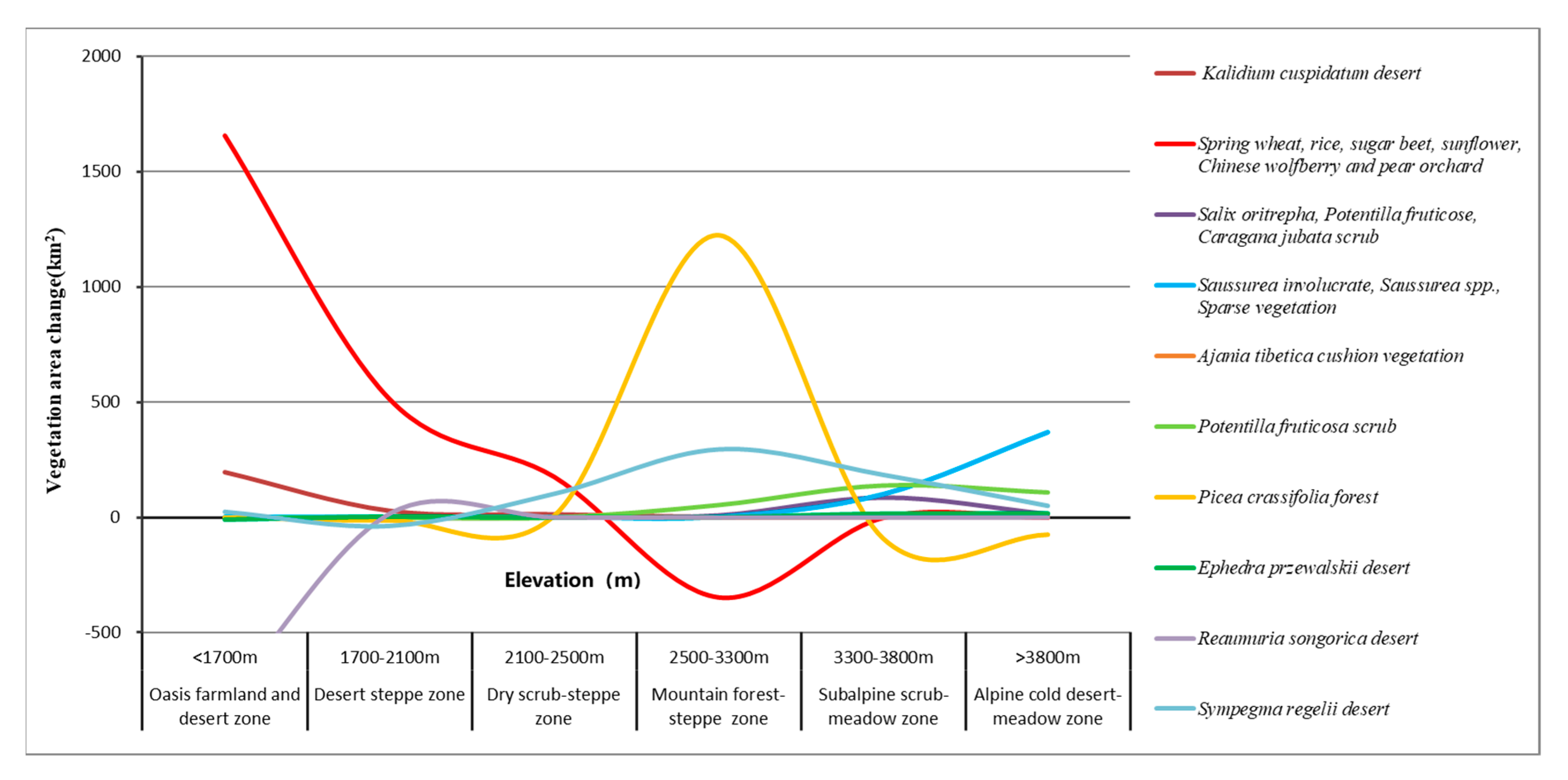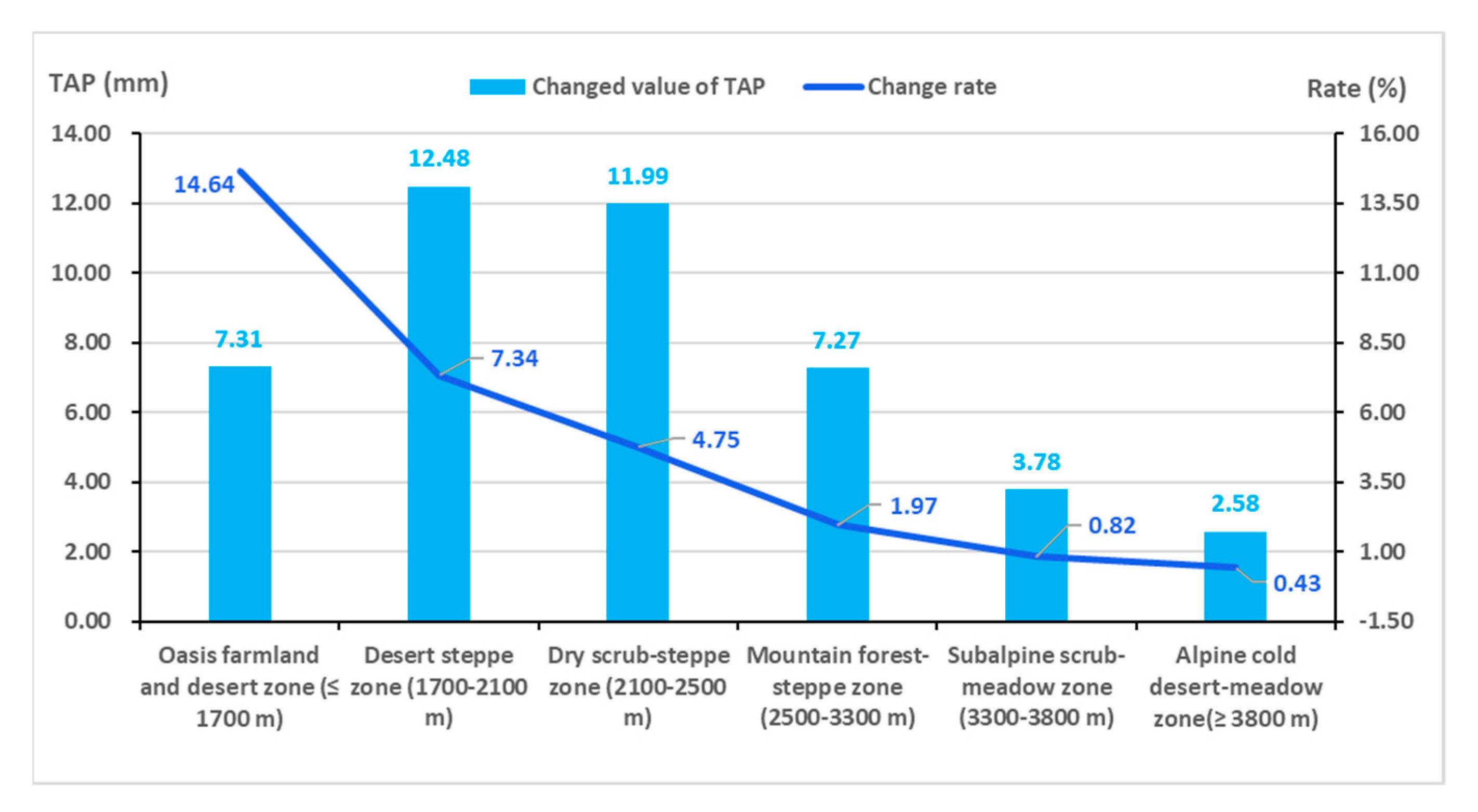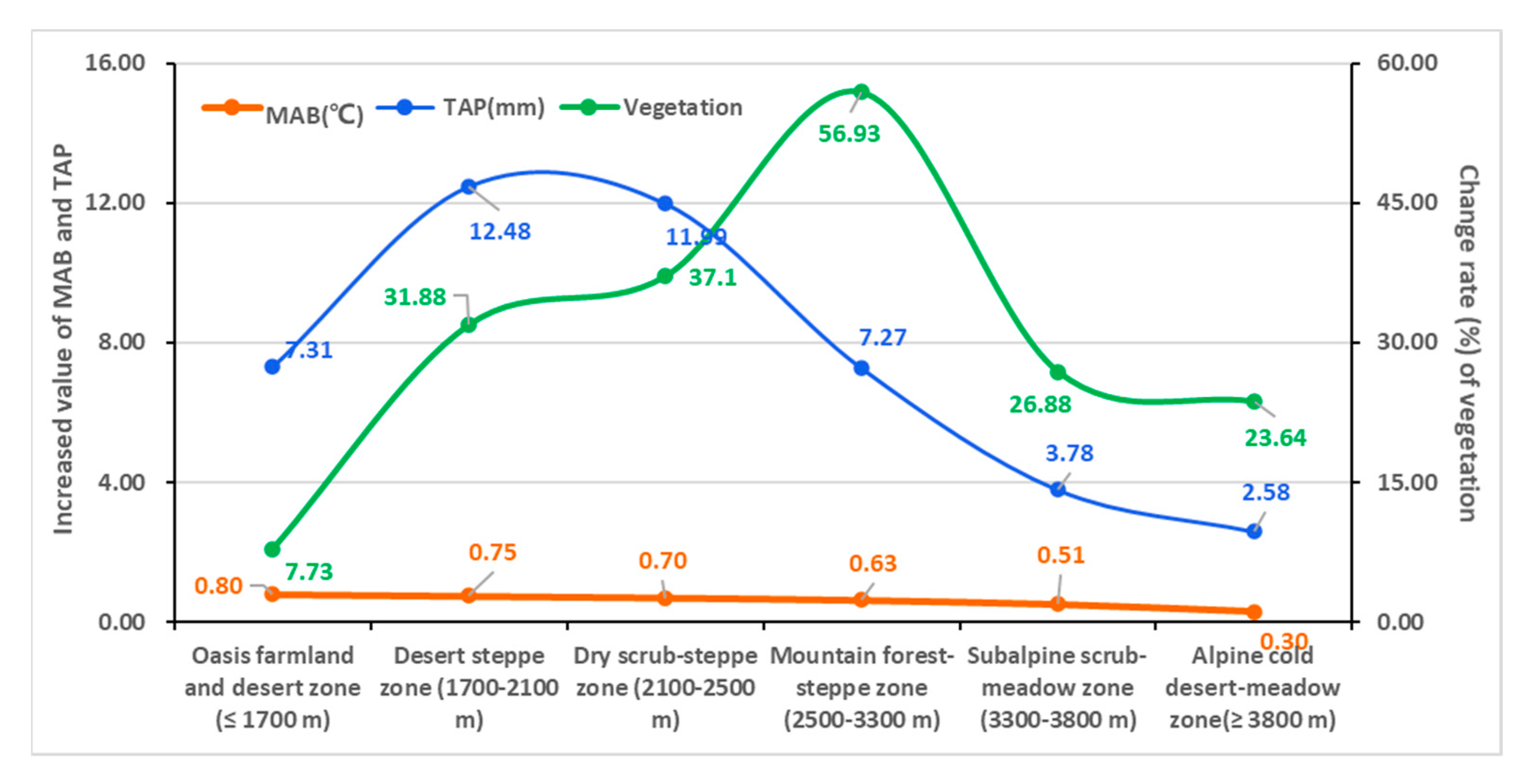Dynamic Patterns of the Vertical Distribution of Vegetation in Heihe River Basin since the 1980s
Abstract
:1. Introduction
2. Materials and Methods
2.1. Study Area
2.2. Data Collection and Processing
2.3. Classification of the Vertical Vegetation Zone
2.4. A dynamic Index of Vegetation Distribution
2.5. A Spatial Change Index of Climate Elements
3. Results
3.1. Dynamic Changes of Vegetation Types
3.2. Change Trends of Vegetation in Different Elevation Zones
3.3. Dynamic Changes of Typical Plant Species in the Different Elevation Zones
3.4. Change Trends of Climate in the Differrent Elevation Zones
4. Discussion
5. Conclusions
Funding
Data Availability Statement
Conflicts of Interest
References
- Quinn, J.F.; Dunham, A.E. On hypothesis testing in ecology and evolution. Am. Nat. 1983, 122, 602–617. [Google Scholar] [CrossRef]
- Legendre, P.; Fortin, M.J. Spatial pattern and ecological analysis. Vegetation 1989, 80, 107–138. [Google Scholar] [CrossRef]
- Borcard, D.; Legendre, P.; Drapeau, P. Partialling out the spatial component of ecological variation. Ecology 1992, 73, 1045–1055. [Google Scholar] [CrossRef] [Green Version]
- Parmesan, C.; Yohe, G. A globally coherent fingerprint of climate change impacts across natural systems. Nature 2003, 421, 37–42. [Google Scholar] [CrossRef]
- Loarie, S.R.; Duffy, P.B.; Hamilton, H.; Asner, G.P.; Field, C.B.; Ackerly, D.D. The velocity of climate change. Nature 2009, 462, 1052–1055. [Google Scholar] [CrossRef]
- Chmura, D.J.; Anderson, P.D.; Howe, G.T.; Harrington, C.A.; Halofsky, J.E.; Peterson, D.L.; Shaw, D.C.; Brad StClair, J. Forest responses to climate change in the northwestern United States: Ecophysiological foundations for adaptive management. For. Ecol. Manag. 2011, 261, 1121–1142. [Google Scholar] [CrossRef]
- He, M.Z.; Zheng, J.G.; Li, X.R.; Qian, Y.L. Environmental factors affecting vegetation composition in the Alxa Plateau, China. J. Arid Environ. 2007, 69, 473–489. [Google Scholar] [CrossRef]
- Zhang, X.L.; Guan, T.Y.; Zhou, J.H.; Cai, W.T.; Gao, N.N.; Du, H.; Jiang, L.H.; Lai, L.M.; Zheng, Y.R. Groundwater depth and soil properties are associated with variation in vegetation of a Desert Riparian ecosystem in an Arid Area of China. Forests 2018, 9, 34. [Google Scholar] [CrossRef] [Green Version]
- Guisan, A.; Zimmermann, N.E. Predictive habitat distribution models in ecology. Ecol. Model. 2000, 135, 147–186. [Google Scholar] [CrossRef]
- Dorothy, P. Sensitivity and rapidity of vegetational response to abrupt climate change. Proc. Natl. Acad. Sci. USA 2000, 97, 1359–1361. [Google Scholar]
- Dobson, A.P.; Bradshaw, A.D.; Baker, A.J.M. Hopes for the future: Restoration ecology and conservation biology. Science 1997, 277, 515–522. [Google Scholar] [CrossRef]
- Emanuel, W.R.; Shugart, H.H.; Stevenson, M.P. Climatic change and the broad-scale distribution of terrestrial ecosystem complexes. Clim. Chang. 1985, 7, 29–43. [Google Scholar] [CrossRef]
- Leemans, R.; Eickhout, B. Another reason for concern: Regional and global impacts on ecosystems for different levels of climate change. Glob. Environ. Chang. 2004, 14, 219–228. [Google Scholar] [CrossRef]
- Zhou, X.; Fan, Z.M.; Yue, T.X. Simulation of vegetation distribution in Heihe River Basin based on SVM. J. Geo. Inf. Sci. 2017, 19, 493–501. [Google Scholar]
- Dolezal, J.; Dvorsky, M.; Kopecky, M. Vegetation dynamics at the upper elevational limit of vascular plants in Himalaya. Sci. Rep. 2016, 6, 24881. [Google Scholar] [CrossRef] [PubMed] [Green Version]
- Wuyts, B.; Champneys, A.R.; House, J.I. Amazonian forest-savanna biostability and human impact. Nat. Commun. 2017, 8, 15519. [Google Scholar] [CrossRef] [Green Version]
- Fan, Z.; Zhang, X.; Li, J.; Yue, T.; Liu, J.; Xiang, B.; Kuang, W. Land-cover changes of national nature reserves in China. J. Geogr. Sci. 2013, 23, 258–270. [Google Scholar] [CrossRef]
- Fan, Z.M.; Li, J.; Yue, T.X. Land-cover changes of biome transition zones in Loess Plateau of China. Ecol. Model. 2013, 252, 129–140. [Google Scholar] [CrossRef]
- He, Z.B.; Zhao, W.Z. Characterizing the spatial structures of riparian plant communities in the lower reaches of the Heihe River in China using geostatistical techniques. Ecol. Res. 2006, 21, 551–559. [Google Scholar] [CrossRef]
- Yuan, L.H.; Chen, X.Q.; Wang, X.Y.; Xiong, Z.; Song, C.Q. Spatial associations between NDVI and environmental factors in the Heihe River Basin. J. Geogr. Sci. 2019, 29, 1548–1564. [Google Scholar] [CrossRef] [Green Version]
- Jiang, X.H.; Liu, C.M. The influence of water regulation on vegetation in the lower Heihe River. J. Geogr. Sci. 2010, 20, 701–711. [Google Scholar] [CrossRef]
- Wang, X.F.; Ma, M.G.; Huang, G.H.; Veroustraete, F.; Zhang, Z.H.; Song, Y.; Tan, J.L. Vegetation primary production estimation at maize and alpine meadow over the Heihe River Basin, China. Int. J. Appl. Earth Obs. Geoinf. 2012, 17, 94–101. [Google Scholar] [CrossRef]
- Pauli, H.; Gottfried, M.; Dullinger, S.; Abdaladze, O.; Akhalkatsi, M.; Alonso, J.L.B.; Coldea, G.; Dick, J.; Erschbamer, B.; Calzado, R.F.; et al. Recent plant diversity changes on Europe’s mountain summits. Science 2012, 336, 353–355. [Google Scholar] [CrossRef] [Green Version]
- Fan, Z.M.; Li, S.B.; Fang, H.Y. Explicitly identifying the desertification change in CMREC area based on multisource remote data. Remote Sens. 2020, 12, 3170. [Google Scholar] [CrossRef]
- Adger, W.N.; Brown, K. Land Use and the Causes of Global Warming; John Wiley: New York, NY, USA, 1994. [Google Scholar]
- Smith, T.B.; Wayne, R.K.; Girman, D.J.; Bruford, M.W. A role for ecotones in generating rainforest biodiversity. Science 1997, 276, 1855–1857. [Google Scholar] [CrossRef]
- Mayle, F.E.; Burbridge, R.; Killeen, T.J. Millennial-scale dynamics of southern amazonian rain forests. Science 2000, 290, 2291–2294. [Google Scholar] [CrossRef] [Green Version]
- Chapin, F.S., III; Zavaleta, E.S.; Eviner, V.T.; Naylor, R.L.; Vitousek, P.M.; Reynolds, H.L.; Hooper, D.U.; Lavorel, S.; Sala, O.E.; Hobbie, S.E.; et al. Consequences of changing biodiversity. Nature 2000, 405, 234–242. [Google Scholar] [CrossRef] [PubMed]
- Marshall, C.J.; Liebherr, J.K. Cladistic biogeography of the Mexican transition zone. J. Biogeogr. 2000, 27, 203–216. [Google Scholar] [CrossRef]
- Loehle, C. Disequilibrium and relaxation times for species responses to climate change. Ecol. Model. 2018, 384, 23–29. [Google Scholar] [CrossRef]
- Yue, T.X.; Liu, Y.; Zhao, M.W.; Du, Z.P.; Zhao, N. A fundamental theorem of Earth’s surface modelling. Environ. Earth Sci. 2016, 75, 751. [Google Scholar] [CrossRef]
- Yue, T.X. Surface Modelling: High Accuracy and High Speed Methods; CRC Press: New York, NY, USA, 2011. [Google Scholar]
- Yue, T.X.; Zhao, N.; Ramsey, R.D.; Wang, C.L.; Fan, Z.M.; Chen, C.F.; Lu, Y.M.; Li, B.L. Climate change trend in China, with improved accuracy. Clim. Chang. 2013, 120, 137–151. [Google Scholar] [CrossRef]
- Yue, T.X.; Zhao, N.; Liu, Y.; Wang, Y.F.; Zhang, B.; Du, Z.P.; Fan, Z.M.; Shi, W.J.; Chen, C.F.; Zhao, M.W.; et al. A fundamental theorem for eco-environmental surface modelling and its applications. Sci. China Earth Sci. 2020, 63, 1092–1112. [Google Scholar] [CrossRef]
- Fan, Z.M.; Bai, X.Y. Scenarios of potential vegetation distribution in the different gradient zones of Qinghai-Tibet Plateau under future climate change. Sci. Total Environ. 2021, 796, 148918. [Google Scholar] [CrossRef]
- Zhou, S.; Yu, B.F.; Zhang, Y.; Huang, Y.F.; Wang, G.Q. Water use efficiency and evapotranspiration partitioning for three typical ecosystems in the Heihe River Basin, northwestern China. Agric. For. Meteorol. 2018, 253, 261–273. [Google Scholar] [CrossRef]
- Fan, Z.M.; Fan, B. Shifts of the mean center of potential vegetation ecosystems under future climate change in Eurasia. Forests 2019, 10, 873. [Google Scholar] [CrossRef] [Green Version]
- Fan, Z.M.; Bai, R.Y.; Yue, T.X. Spatio-temporal distribution of vascular plant species abundance on Qinghai-Tibet Plateau. J. Geogr. Sci. 2019, 29, 1625–1636. [Google Scholar] [CrossRef]
- Gao, X.; Huang, X.X.; Lo, K.; Dang, Q.W.; Wen, R.Y. Vegetation responses to climate change in the Qilian Mountain Nature Reserve, Northwest China. Glob. Ecol. Conserv. 2021, 28, e01698. [Google Scholar] [CrossRef]
- Shen, Q.; Ma, Y. Did water diversion projects lead to sustainable ecological restoration in arid endorheic basins? Lessons from long-term changes of multiple ecosystem indicators in the lower Heihe River Basin. Sci. Total Environ. 2020, 701, 134785. [Google Scholar] [CrossRef]
- Fan, Z.M.; Fan, B.; Yue, T.X. Terrestrial ecosystem scenarios and their response to climate change in Eurasia. Sci. China Earth Sci. 2019, 62, 1607–1618. [Google Scholar] [CrossRef]
- Fan, Z.M. Response analysis of gradient distribution of vegetation to climate change in Heihe River Basin. Acta Ecol. Sin. 2021, 41, 4066–4076. [Google Scholar]
- Williams, A.P.; Allen, C.D.; Millar, C.I.; Swetnam, T.W.; Michaelsen, J.; Still, C.J.; Leavitt, S.W. Forest responses to increasing aridity and warmth in the southwestern United States. Proc. Natl. Acad. Sci. USA 2010, 107, 21289–21294. [Google Scholar] [CrossRef] [PubMed] [Green Version]
- Wu, F.; Zhan, J.Y.; Chen, J.C.; He, C.; Zhang, Q. Water yield variation due to forestry change in the head-water area of Heihe River Basin, Northwest China. Adv. Meteorol. 2015, 786764, 786764. [Google Scholar] [CrossRef]








Publisher’s Note: MDPI stays neutral with regard to jurisdictional claims in published maps and institutional affiliations. |
© 2021 by the author. Licensee MDPI, Basel, Switzerland. This article is an open access article distributed under the terms and conditions of the Creative Commons Attribution (CC BY) license (https://creativecommons.org/licenses/by/4.0/).
Share and Cite
Fan, Z. Dynamic Patterns of the Vertical Distribution of Vegetation in Heihe River Basin since the 1980s. Forests 2021, 12, 1496. https://doi.org/10.3390/f12111496
Fan Z. Dynamic Patterns of the Vertical Distribution of Vegetation in Heihe River Basin since the 1980s. Forests. 2021; 12(11):1496. https://doi.org/10.3390/f12111496
Chicago/Turabian StyleFan, Zemeng. 2021. "Dynamic Patterns of the Vertical Distribution of Vegetation in Heihe River Basin since the 1980s" Forests 12, no. 11: 1496. https://doi.org/10.3390/f12111496
APA StyleFan, Z. (2021). Dynamic Patterns of the Vertical Distribution of Vegetation in Heihe River Basin since the 1980s. Forests, 12(11), 1496. https://doi.org/10.3390/f12111496





